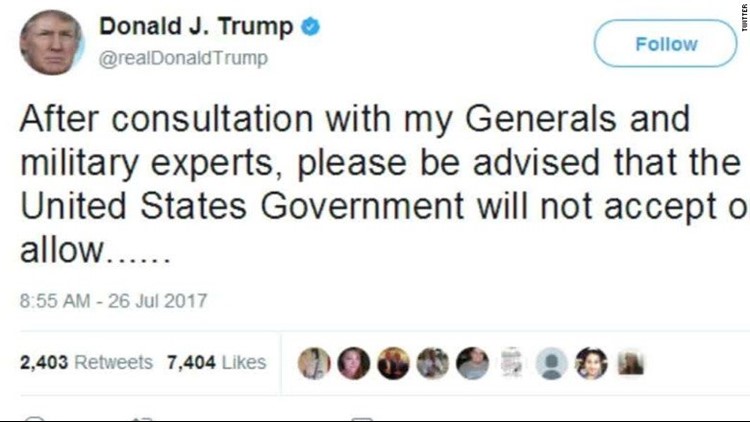WASHINGTON — President Donald Trump announced Wednesday that he plans to reinstate a ban on transgender individuals from serving “in any capacity” in the US armed forces.
The decision reversed a policy initially approved by the Defense Department under President Barack Obama, which was still under final review, that would allow transgender individuals to openly serve in the military. Defense Secretary James Mattis announced last month that he was delaying enactment of the plan to begin allowing transgender individuals to join the US military.
“After consultation with my Generals and military experts, please be advised that the United States Government will not accept or allow Transgender individuals to serve in any capacity in the U.S. Military,” Trump said in a series of tweets Wednesday morning. “Our military must be focused on decisive and overwhelming victory and cannot be burdened with the tremendous medical costs and disruption that transgender in the military would entail.”
“Thank you,” he added.
Ash Carter, the Defense secretary under Obama, ended the ban on transgender people serving openly in the military in 2016, but allowed for a year-long review process to allow the Pentagon to determine how it would accept new transgender recruits into the military.
On the eve of that one-year deadline, Mattis announced that he was delaying the implementation of the new policy, saying he needed more time.
“Since becoming the Secretary of Defense, I have emphasized that the Department of Defense must measure each policy decision against one critical standard: will the decision affect the readiness and lethality of the force?” Mattis said in a memo late last month. “Put another way, how will the decision affect the ability of America’s military to defend the nation? It is against this standard that I provide the following guidance on the way forward in accessing transgender individuals into the military Services.”
A 2016 Rand Corp. study commissioned by the Defense Department concluded that letting transgender people serve openly would have a “minimal impact” on readiness and health care costs, largely because there are so few in the military’s 1.3 million-member force.
The study put the number of transgender people in the military between 1,320 and 6,630. Gender-change surgery is rare in the general population, and the RAND study estimated the possibility of 30 to 140 new hormone treatments a year in the military, with 25 to 130 gender transition-related surgeries among active service members. The cost could range from $2.4 million and $8.4 million, an amount that would represent an “exceedingly small proportion” of total health care expenditures, the study found.
Trump’s decision marks a setback for LGBT rights groups who have expressed concerns that the Trump administration could chip away at progress the community has seen in recent years on the backs of a series of landmark decisions in recent years that have included the legalization of same-sex marriage nationwide and a repeal of the ban on gay people openly serving in the military.
Trump’s decision is also another setback for the transgender community following his decision several months ago to reverse an Obama administration policy allowing transgender students to use the bathroom of their choice.
The Obama administration faced heated criticism from the right last year when it announced the military ban and several Republican members of Congress have urged the Trump administration to reverse the decision, arguing that the decision does not serve the US’ defense interests.



